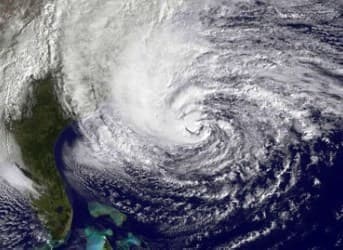There is nothing like a major hurricane on the eve of a US presidential election to ensure that energy is highlighted as a make-or-break issue for voters, and to force the candidates to get very specific.
This confluence of events will reverberate across a variety of sectors and issues, from climate change and renewable energy policy to electricity distribution and emergency response systems, all the way to insurance policy and the balance of power between the federal and state governments and the public and private sector.
This is Mother Nature’s power, and her timing could not be more informing.
The climate change debate tends to resurface rather strongly in the event of a major weather incident, and certainly Mother Nature in this case manages to score points for the climate change “alarmists”. From a campaign perspective, then, Hurricane Sandy is likely to boost Obama’s policy of investing federal money into new technologies apparently designed to reduce climate change.
From here, though, the biggest dilemma is for insurance companies, for whom Hurricane Sandy forces a decision: Whether to invest in technologies that would reduce climate change and hence possibly the risk related to severe weather incidents; or whether to hedge their bets that these severe weather incidents are just natural patterns unrelated to man-made climate change and hence unavoidable. It’s a big decision, as Hurricane Sandy could cost them some $20 billion.
Related Article: Hurricane Sandy: Litmus Test for America's Utilities
The question of federal vs state authority becomes a very specific campaign issue in the face of Hurricane Sandy, with Republican candidate Mitt Romney unsure how to respond to the traditional Republican stance that state’s should have more power. In the face of Hurricane Sandy, the public is likely more comfortable knowing that the Federal government is responsible for emergency action, though the Republicans would like to see states given first-responder status. The Democrats are arguing that the Federal government must come to the aid of the states hit by Hurricane Sandy. The end game here is all about budgets and limits.
While there are a few areas for Obama to score points here, his administration is certainly being held under more scrutiny as everyone watches the emergency response time and methods closely.
A shortage of fuel, despite the Federal Emergency Management Agency (FEMA) efforts, is only adding to the anger of drivers already disillusioned over high gas prices. According to media reports, FEMA contracted out 24 million gallons of fuel and sent 230 fuel trucks into New York and New Jersey where they were to be distributed by the National Guard. However, the shortages are apparently still being felt and there seems to be some confusion as to where the FEMA fuel has actually gone. The National Guards say they are out of gas and still waiting for FEMA deliveries.
As of yesterday, the number of homes and business still without power after Hurricane Sandy was about 1.9 million. This is positive news, as it’s down from 2.5 million the day before. How this is perceived by the public is another question. As it stands, it’s still lights out for one-quarter of the population of New Jersey, and one-tenth of New Yorkers.
By. Charles Kennedy of Oilprice.com


















